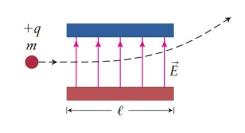In an inkjet printer, tiny drops of ink of inertia (m) are given a charge (q) and
Question:
In an inkjet printer, tiny drops of ink of inertia \(m\) are given a charge \(q\) and then fired toward the paper at speed \(v\). They first pass between two charged plates of length \(\ell\) that create a uniform electric field of magnitude \(E\) between them (Figure P23.33). The field direction is perpendicular to the plates and to the initial path of the drops. The electric field deflects each drop from its initial horizontal path and is used to control what is printed on the paper.
(a) Derive an expression for how far in the vertical direction a drop is deflected as it passes between the plates.
\((b)\) For a drop inertia of \(1.5 \times 10^{-10} \mathrm{~kg}\), an electric field strength of \(1.2 \times 10^{6} \mathrm{~N} / \mathrm{C}\), a plate length of \(10 \mathrm{~mm}\), and a drop speed of \(20 \mathrm{~m} / \mathrm{s}\), calculate the drop charge necessary to result in a deflection of \(1.3 \mathrm{~mm}\).
(c) Is it acceptable to ignore the effects of gravity in this case?
Data from Figure P23.33

Step by Step Answer:






